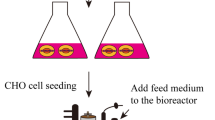Abstract
Purpose
The aim of this work was to evaluate the effect of a Vero cell coculture system on the development of mouse embryos.
Methods
Mouse embryos were randomly divided and cultured in human tubal fluid (HTF) medium with/without Vero cell monolayers, conditioned medium (CM) obtained from Vero cell cultures, and HTF medium supplemented with peptides extracted from CM. The concentrated CM was examined by SDS/PAGE.
Results
The development of mouse embryos was blocked at the blastocyst stage in pure HTF medium (1.4% hatching at day 5). This “blastocyst block≓ was overcome by coculture with Vero cell monolayers (48.1% hatching at day 5; 1.4 vs 48.1%; P<0.001). CM and the addition of 5% fetal bovine serum (24.1 and 34.9% hatching, respectively, at day 5) were also able to enhance the process of hatching. In the other experiment, the addition of peptides extracted from Vero cell cultures also overcame the blastocyst block (12.5%) compared with pure HTF medium (2.1%) (P<0.05). Electrophoretic separation revealed several classes of polypeptides consistently secreted into CM obtained from Vero cell cultures. Most peptides occurred in the Mr range between 6.5 kd and 35.9 kd.
Conclusion
A developmental block (blastocyst block) of mouse embryos in a serum- and protein-free medium (HTF) was discovered in this study. This block was effectively overcome by HTF plus serum and coculture with Vero cell monolayers and also by the peptides extracted from Vero cell-conditioned medium. We speculate that certain factors secreted or converted by Vero cells may be critical in hatching of mouse embryos. Further study of these factors may be helpful in delineating its mechanism.
Similar content being viewed by others
References
Edwards RG, Steptoe PC, Purdy JM: Establishing full term human pregnancies using cleaving embryos grown in vitro. Br J Obstet Gynecol 1980;87:737–740
The American Fertility Society: In vitro fertilization-embryo transfer (IVF-ET) in the United States: 1990 results from the IVF-ET Registry. Fertil Steril 1992;57:15–24
Bongso A, Ng SC, Mok H, Lim MN, Teo HL, Wong PC, Ratnam SS: Effect of sperm motility on human in vitro fertilization. Arch Androl 1989;22:185–190
Bolton VN, Hawes SM, Taylor CT, Parsons JH: Development of spare human preimplantation embryos in vitro: An analysis of the correlations among gross morphology, cleavage rates, and development to the blastocyst. J Vitro Fert Embryo Transfer 1989;6:30–35
Bongso A, Ng SC, Fong CY, Ratnam S: Cocultures: A new lead in embryo quality improvement for assisted reproduction. Fertil Steril 1991;56:179–191
Ouhibi N, Hamidi J, Guillaud J, Menezo Y: Co-culture of 1-cell mouse embryos on different cell supports. Hum Reprod 1990;5:737–743
Czlonkowska M, Eysymont U, Guszkiewicz A, Kossakowski M, Dziak J: Birth of lambs after in vitro maturation, fertilization, and coculture with oviductal cells. Mol Reprod Dev 1991;30:34–38
Goldberg JM, Khalifa EADM, Friedman CI, Kim MH: Improvement of in vitro fertilization and early embryo development in mice by coculture with human fallopian tube epithelium. Am J Obstet Gynecol 1991;165:1802–1805
Eyestone WH, First NL: Co-culture of early cattle embryos to the blastocyst stage with oviductal tissue or in conditioned medium. J Reprod Fertil 1980;85:715–720
Ellington JE, Carney EW, Farrell PB, Simkin ME, Foote RH: Bovine 1-2-cell embryo development using a simple medium in three oviduct epithelial cell coculture systems. Biol Reprod 1990;43:97–104
Bongso A, Ng SC, Ratnam S: Co-cultures: Their relevance to assisted reproduction. Hum Reprod 1990;5:893–900
Bongso A, Ng SC, Sathananthan H, Ng PL, Rauff M, Ratnam S: Improved quality of human embryos when cocultured with human ampullary cells. Hum Reprod 1989;4:706–713
Menezo YIR, Guerin JF, Czyba JC: Improvement of human early embryo development in vitro by coculture on monolayers of Vero cells. Biol Reprod 1990;42:301–306
Bongso A, Ng SC, Fong CY, Anandakumar C, Marshall B, Edirisinghe R, Ratnam S: Improved pregnancy rate after transfer of embryos grown in human fallopian tubal cell coculture. Fertil Steril 1992;58:569–574
Lai YM, Stein DE, Soong YK, Tang YX, Grifo J, Malter HE, Talansky BE, Cohen J, Liu HC, Rosenwaks Z: Evaluation of Vero cell co-culture system for mouse embryos in various media. Hum Reprod 1992;7:276–280
Gandolfi F, Brevini TAL, Richardson L, Brown CR, Moor RM: Characterization of proteins secreted by sheep oviduct epithelial cells and their function in embryonic development. Development 1989;106:303–312
Butzo R: The human fallopian tube contains placental protein 5. Hum Reprod 1989;4:17–20
Wiemer K, Amborski G, Denniston R, Godke R: Use of a hormone-treated fetal uterine fibroblast monolayer for in vitro development for bovine embryos. Theriogenology 1987;27:294–299
Goto K, Kajihara Y, Kosaka S, Koba M, Nakanishi Y, Ogewa K: Pregnancies after co-culture of cumulus cells withbovine embryos derived from in-vitro fertilization of in-vitro matured follicular oocytes. J Reprod Fertil 1988;83:753–758
Wiemer KE, Cohen J, Amborske GF, Wright G, Wiker S, Munyakazi L, Godke RA: In vitro development and implantation of human embryos following culture on fetal bovine uterine fibroblast cells. Hum Reprod 1989;4:595–600
Author information
Authors and Affiliations
Rights and permissions
About this article
Cite this article
Chen, HF., Ho, HN., Chen, SU. et al. Peptides extracted from vero cell cultures overcome the blastocyst block of mouse embryos in a serum-free medium. J Assist Reprod Genet 11, 165–171 (1994). https://doi.org/10.1007/BF02332095
Received:
Accepted:
Issue Date:
DOI: https://doi.org/10.1007/BF02332095




